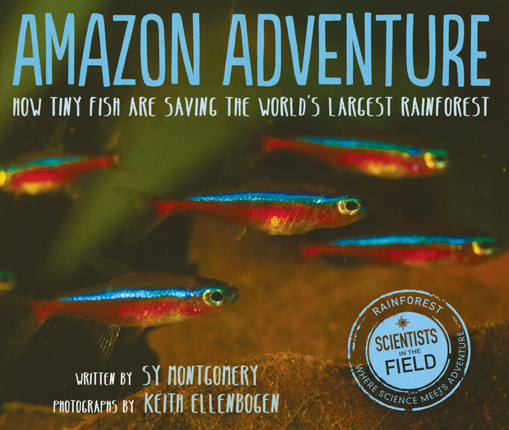Full Text Reviews: Booklist - 05/15/2017 *Starred Review* Sibert Medal–winning Montgomery returns to the impressive Scientists in the Field series with this narrative account of one little fish. The Amazon, an essential part of the earth’s ecosystem, is teeming with life; new species are still regularly discovered there. Montgomery and photographer Keith Ellenbogen join forces with Boston aquarist Scott Dowd in search of piaba, a bright, shy fish that plays a large role in the preservation of the Amazon. Sold as valuable pets, the gathering of these fish has led to a flourishing trade: piabeiros who gently fish for piabas from canoes. Removing the piabas from their natural habitat may seem detrimental, but overcrowding during the dry season means almost 90 percent of piabas are stranded. Furthermore, piabeiros rely on their trade and protect their industry, keeping this stretch of the Amazon free of the industries that pollute other areas; the fishery becomes not only sustainable but mutually beneficial. Montgomery thoroughly mines the social and economic effects the piabas have on locals, alongside an in-depth exploration of the Amazon River and its ecosystems. The science and sociology are interesting and unusual, and the narrative itself enthralling: a nerve-racking section detailing the most dangerous inhabitants of the Amazon River, just before Ellenbogen submerges himself, will have readers holding their breath (those dangers are, mostly, debunked several pages later). A true-to-form installment in a valuable series. - Copyright 2017 Booklist. School Library Journal - 07/01/2017 Gr 5–8—Scientists studying fish ecology in specific biomes often dwell on the evils of overfishing, but along the Río Negro, a major tributary to the mighty Amazon, scientist Scott Dowd has noticed something radically different: a fishing industry that not only supports the human population in this rain forest area but also protects the ecology. Essential to the balance are thousands of tiny fish, or "piaba," such as cardinal tetras, which are beloved by aquarium keepers for their brilliant shades of neon reds and electric blues. Dowd was appalled on his first visit to the region after seeing the vast numbers of these small fish being brought to the market for sale, believing the entire ecology of the rivers was at risk. He ultimately learned that the majority of them would have died as the rainy season ended and the once-flooded Amazonian forest dried out. Instead, the careful management of the local fishermen preserved the forest and "saved" the fish. Since his initial visit in 1991, Dowd and other members of his research team have been exploring this unusual balance between wild nature and human economy, finding the other animals this industry protects, from pink dolphins to Goliath birdeater tarantulas. Montgomery's knowledgeable text paints a clear picture of this way of life that's relatively unknown to many. A plethora of color photos splash across the pages, some muddy in texture owing to the tannin-hued waters of the Río Negro, but their message is as lucid as the text. This fishing industry is a lifesaver. VERDICT Another addition to a spectacular series, this is an eye-opening first purchase for science collections.—Patricia Manning, formerly at Eastchester Public Library, NY - Copyright 2017 Publishers Weekly, Library Journal and/or School Library Journal used with permission. Loading...
|




